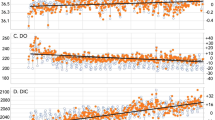The coming centuries may see more ocean acidification than the past 300 million years.
Abstract
Most carbon dioxide released into the atmosphere as a result of the burning of fossil fuels will eventually be absorbed by the ocean1, with potentially adverse consequences for marine biota2,3,4. Here we quantify the changes in ocean pH that may result from this continued release of CO2 and compare these with pH changes estimated from geological and historical records. We find that oceanic absorption of CO2 from fossil fuels may result in larger pH changes over the next several centuries than any inferred from the geological record of the past 300 million years, with the possible exception of those resulting from rare, extreme events such as bolide impacts or catastrophic methane hydrate degassing.
This is a preview of subscription content, access via your institution
Access options
Subscribe to this journal
Receive 51 print issues and online access
$199.00 per year
only $3.90 per issue
Buy this article
- Purchase on SpringerLink
- Instant access to full article PDF
Prices may be subject to local taxes which are calculated during checkout

Similar content being viewed by others
References
Houghton, J. T. et al. (eds) Climate Change 2001: The Scientific Basis (Contribution of Working Group I to the Third Assessment Report of the IPCC, Cambridge Univ. Press, Cambridge, 2001).
Kleypas, J. A. et al. Science 284, 118–120 (1999).
Riebesell, U. et al. Nature 407, 364–367 (2000).
Seibel, B. A. & Walsh, P. J. Science 294, 319–320 (2001).
Caldeira, K. & Duffy, P. B. Science 287, 620–622 (2000).
Metz, B., Davidson, O., Swart, R. & Pan, J. (eds) Climate Change 2001: Mitigation (Contribution of Working Group III to the Third Assessment Report of the IPCC, Cambridge Univ. Press, Cambridge, 2001).
Marland, G., Boden, T. A. & Andres, R. J. Global, regional, and national CO2 emissions. Trends: A Compendium of Data on Global Change http://cdiac.esd.ornl.gov/trends/emis/tre_glob.htm (2002).
Caldeira, K. & Rampino, M. R. Paleoceanography 8, 515–525 (1993).
Caldeira, K. & Rau, G. H. Geophys. Res. Lett. 27, 225–228 (2000).
Crowley, T. J. & Berner, R. A. Science 292, 780–781 (2001).
Caldeira, K., Berner, R., Sundquist, E. T., Pearson, P. N. & Palmer, M. R. Science 286, 2043 (1999).
Beerling, D. J. & Berner, R. A. Global Biogeochem. Cycles 16, 101–113 (2002).
Sanyal, A., Hemming, N. G., Hanson, G. N. & Broecker, W. S. Nature 373, 234–236 (1995).
Author information
Authors and Affiliations
Corresponding author
Ethics declarations
Competing interests
The authors declare no competing financial interests.
Rights and permissions
About this article
Cite this article
Caldeira, K., Wickett, M. Anthropogenic carbon and ocean pH. Nature 425, 365 (2003). https://doi.org/10.1038/425365a
Issue Date:
DOI: https://doi.org/10.1038/425365a
This article is cited by
-
Recent advancements in marine micropaleontological and paleoceanographic research from India
Proceedings of the Indian National Science Academy (2024)
-
Impact of Climate Change on the Dynamic Processes of Marine Environment and Feedback Mechanisms: An Overview
Archives of Computational Methods in Engineering (2024)
-
Resiliency of black sea bass, Centropristis striata, early life stages to future high CO2 conditions
Environmental Biology of Fishes (2024)
-
Contrasting patterns in pH variability in the Arabian Sea and Bay of Bengal
Environmental Science and Pollution Research (2024)
-
Impacts of ocean acidification on physiology and ecology of marine invertebrates: a comprehensive review
Aquatic Ecology (2024)



